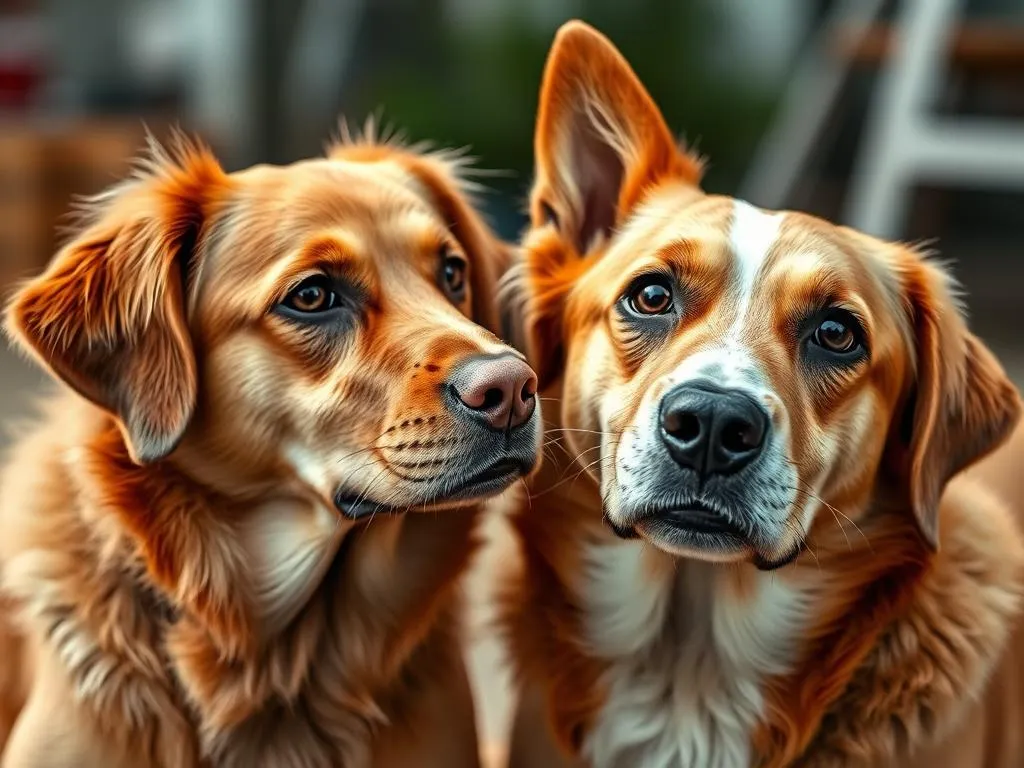
Introduction
The bond between humans and dogs is one of the most cherished relationships in the animal kingdom. Dogs have been our companions for thousands of years, evolving alongside us to become not just pets, but beloved family members. Understanding dog behavior is crucial for fostering a harmonious relationship between humans and their canine counterparts. One question often arises in the realm of canine communication: do dogs like eye contact? This article will explore this fascinating topic, delving into canine communication, the science behind eye contact, and how individual factors influence a dog’s response to it.
In the sections that follow, we will uncover what eye contact means for dogs, the psychological aspects involved, and how to navigate this complex form of communication.
Understanding Dog Communication
Canine Body Language
Dogs communicate primarily through body language. Their posture, tail position, and facial expressions convey a wealth of information. For example, a wagging tail can indicate happiness, while a lowered tail might suggest fear or submission. Understanding these signals is essential for any dog owner who wishes to interpret their pet’s feelings accurately.
Eye contact is a significant part of this communication spectrum. While humans often view prolonged eye contact as a sign of trust and affection, dogs may interpret it differently based on their individual experiences and temperament.
Eye Contact in Animal Behavior
In the animal kingdom, eye contact can signify various emotions and intentions. Many predators, including wolves and big cats, use direct eye contact as a threat display. Conversely, many prey animals avoid direct eye contact to prevent drawing attention from potential predators. For dogs, however, the interpretation of eye contact hinges on their socialization and relationship with the human offering this gaze.
In essence, do dogs like eye contact? The answer is not straightforward and depends on multiple factors, including the context, the dog’s personality, and the nature of the relationship they have with their human.
The Science Behind Eye Contact
Psychological Studies
Numerous studies have been conducted to better understand dog behavior and the role of eye contact. Research indicates that dogs can read human emotions through facial expressions and may respond positively to eye contact when it occurs in a relaxed and friendly context. A study published in the journal Science found that mutual gaze between dogs and humans increases oxytocin levels—a hormone associated with bonding—in both species. This suggests that dogs may indeed enjoy eye contact in certain situations.
However, other studies warn against assuming that all dogs will respond positively to direct eye contact. Some dogs may feel threatened or uncomfortable, especially if they have had negative experiences in the past. This highlights the importance of observing individual reactions to eye contact.
The Role of Oxytocin
Oxytocin, often referred to as the “bonding hormone,” plays a crucial role in the relationship between dogs and humans. When dogs and their owners engage in eye contact, oxytocin levels in both parties can increase, strengthening their emotional bond. This hormonal response is similar to that seen in mother-infant interactions in humans, suggesting that dogs may thrive on eye contact when it occurs in a safe and nurturing environment.
Understanding how oxytocin influences interactions can help dog owners foster a deeper bond with their pets. However, it’s essential to remember that not all dogs are the same, and their comfort with eye contact can vary widely.
Do Dogs Like Eye Contact?
Positive Reactions to Eye Contact
Many dogs exhibit positive responses to eye contact, particularly when they are comfortable and familiar with their human companions. Dogs may lean in closer, wag their tails, or even nuzzle against their owner’s hand during moments of mutual gaze. Breeds such as Golden Retrievers, Labrador Retrievers, and Poodles are often known for their affectionate nature and may enjoy eye contact more than others.
For instance, you may notice a dog sitting calmly and gazing into their owner’s eyes while receiving affection. This can be a clear indicator that the dog feels secure and is enjoying the interaction.
Negative Reactions to Eye Contact
Conversely, some dogs may perceive direct eye contact as a threat or challenge. In these cases, the dog might display signs of stress or anxiety, such as turning their head away, yawning, or even growling. This is particularly common in dogs that have not been well socialized or those with a history of trauma.
For example, a rescue dog may be more sensitive to direct eye contact if they have experienced neglect or abuse. Recognizing these signs is vital for any dog owner, as it allows them to adjust their behavior and create a more comfortable environment for their pet.
Factors Influencing Dogs’ Attitudes Towards Eye Contact
Individual Personalities
Just as humans have different personalities, so do dogs. A dog’s temperament significantly affects their response to eye contact. Some dogs are naturally more confident and social, while others may be shy or fearful. Socialized dogs tend to be more comfortable with direct eye contact, while unsocialized dogs may view it as a threat.
Understanding your dog’s personality can help you determine how they are likely to react during interactions. For instance, a playful puppy may thrive on eye contact during playtime, while an older, more reserved dog might prefer to avoid it.
Breed-Specific Behaviors
Certain breeds have distinct behaviors that can influence their attitudes toward eye contact. For example, working breeds like Border Collies or German Shepherds may be more focused on tasks and less reliant on eye contact for social bonding. In contrast, companion breeds such as Cavalier King Charles Spaniels and Shih Tzus may seek out eye contact as a way to connect with their owners.
Being aware of these breed-specific tendencies can help owners tailor their interactions with their dogs, fostering a more rewarding relationship.
Previous Experiences
A dog’s past experiences can profoundly influence their comfort level with eye contact. Dogs that have undergone trauma or negative experiences may be more sensitive to direct eye contact, viewing it as a potential threat. Conversely, dogs that have been raised in loving, positive environments may be more inclined to enjoy eye contact as a sign of affection.
Positive reinforcement is crucial for building trust with a dog that may be fearful of eye contact. Slowly introducing eye contact in a gentle, non-threatening manner can help alleviate anxiety and foster a stronger bond.
How to Approach Eye Contact with Your Dog
Building Trust Through Gradual Eye Contact
If you want to help your dog become more comfortable with eye contact, consider starting with gradual exposure. Begin by making soft eye contact for brief periods while engaging in other activities, such as playing or petting. This can help create a positive association with eye contact.
Here are some tips for building trust:
- Use Soft Eye Contact: Instead of staring directly into your dog’s eyes, soften your gaze and allow your eyes to relax. This can help your dog feel more at ease.
- Reward Positive Responses: If your dog makes eye contact and seems relaxed, reward them with praise or treats. This reinforces the behavior positively.
- Create a Safe Environment: Ensure that your dog feels secure in their surroundings. A calm environment can encourage your dog to engage in eye contact without fear.
When to Avoid Eye Contact
While eye contact can be a powerful tool for bonding, there are times when it’s best to avoid it. For example, if you notice signs of discomfort in your dog—such as cowering, growling, or attempting to move away—it’s important to respect their feelings and give them space.
Some situations where avoiding eye contact is advisable include:
- Approaching a Nervous Dog: If you encounter a dog that seems anxious or fearful, avoid direct eye contact to prevent escalating their stress.
- During Training: While training, it may be beneficial to focus on other cues rather than eye contact, especially with dogs that are still learning.
- In Social Settings: In a crowded space with unfamiliar dogs, maintaining a relaxed demeanor, including avoiding direct eye contact, can help prevent misunderstandings or conflicts.
Expert Opinions and Testimonials
Insights from Veterinarians and Dog Trainers
Veterinarians and dog trainers emphasize the significance of understanding canine behavior, including the role of eye contact. Dr. Sarah Johnson, a veterinary behaviorist, notes, “Eye contact can be a double-edged sword. For some dogs, it reinforces the bond, while for others, it can be a source of stress. It’s essential to know your dog’s comfort level.”
Professional dog trainer Mark Roberts adds, “Gradual exposure to eye contact can help build trust, but it’s crucial to respect a dog’s boundaries. Every dog is unique, and what works for one may not work for another.”
Real-Life Experiences from Dog Owners
Many dog owners have shared their experiences regarding eye contact with their pets. Julia, a proud Labrador owner, says, “My dog loves to look me in the eyes when we’re cuddling. It makes me feel closer to him, and I can tell he enjoys it too.”
On the other hand, Tom, who adopted a rescue mutt, explains, “At first, my dog would avoid eye contact completely. I learned to be patient and let him come to me. Now, after months of building trust, he often looks me in the eyes, and it feels amazing.”
These testimonials highlight the diverse experiences dog owners have with eye contact, reinforcing the notion that each dog’s response is unique.
Conclusion
In summary, the question of do dogs like eye contact is complex and multifaceted. While many dogs enjoy and thrive on eye contact as a way to bond with their owners, others may find it intimidating or threatening. Understanding your dog’s individual personality, breed traits, and past experiences is crucial for fostering a healthy and loving relationship.
Eye contact can be a powerful tool for building trust and connection, but it must be approached with care and consideration. By observing your dog’s reactions and adjusting your interactions accordingly, you can enhance the bond you share.
As you continue to engage with your dog, take the time to observe their behavior and adapt your approach to foster a deeper connection. Each moment spent together strengthens the unique bond between you and your furry friend.









